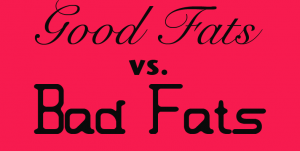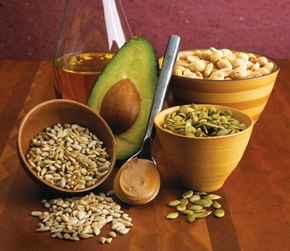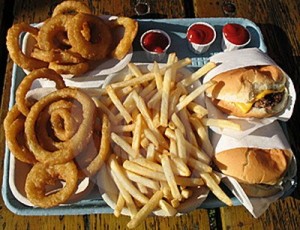One of the biggest diet myths is to stay away from fats: “You’ll gain more weight!” “They are bad for you!” “Non-fat is best for everything if you’re on a diet!” But this is all very untrue. In fact we need fats… the “good fats” not “bad fats”, of course. But, why would we NEED fats and how do we know what’s “good” and what’s “bad”? Well, I’m about to tell you! You can read more about good fats for your health in this book, Get Your Fats Straight. But for now, here is my guide on fats.
Why do we need fats?
- Fats help absorb vitamins and minerals and prevents vitamin deficiencies.
- Fats give us energy that our body needs, especially if blood sugar supply runs out – fat acts as a backup supply.
- If we don’t consume fats we might become deficient in essential fatty acids.
- Fats help us feel full longer because it stays in the stomach longer during digestion.
- Fat helps transfer nutrients across cell membranes.
- Fat aids in making other necessary functions in our body such as hormones and immune functions.
- When we don’t get enough fat we might have many of the following symptoms: dry/scaly skin, extra low body weight, low immune system, hair loss, poor growth, low infection resistance, bruising, and no menstruation cycle.
What are “Good Fats”?
There are two types of “good fats”. They are monounsaturated fats and polyunsaturated fats.
Monounsaturated fats (aka MUFA’s) are fats that lower total cholesterol and LDL cholesterol (the bad cholesterol) while increasing HDL cholesterol (the good cholesterol). Examples of MUFA’s are:
- oils - peanut, sesame, canola, walnut, olive, safflower, soybean, sunflower, flaxseed, pesto sauce
- Nuts and Seeds
– almonds, brazil nuts, natural peanut butter, dry-roasted cashews, dry-roasted peanuts, dry-roasted sunflower seeds, hazelnuts, macadamia nuts, pecans, Pine Nuts
, pistachios, roasted pumpkin seeds, sunflower seeds, walnuts
- avocado – Florida or Hass
- olives – black olives, black olive tapenade, green olives, Green Olive Tapenade
- dark chocolate – dark or semisweet
- See our Flat Belly Coach app, which follows a diet plan that focuses on including a MUFA in each meal. It’s a healthy weight loss plan for sure. Buy it here:
 Or check out the official book Flat Belly Diet!
Or check out the official book Flat Belly Diet! if you don’t have an iPhone.
Polyunsaturated fats also lower total cholesterol and LDL cholesterol. Examples include:
- Fish – salmon, trout, herring, mackerel
- vegetable oils – safflower, soybean and corn
- seeds and nuts – pumpkin seeds, sesame seeds, sunflower seeds, flaxseed, walnuts
- soy products – soy milk and tofu
What are the bad fats?
There are two types of bad fats: saturated fats and trans fats.
Saturated fats raise both your total blood cholesterol and your LDL cholesterol (the bad cholesterol). Examples to stay away from:
- animal products – high fat cuts of meat, chicken with skin, dairy, ice cream, eggs, butter, lard and seafood.
- oils – palm oil, palm kernel oil and coconut oil.
Trans fats are the worst of the worst! Trans fats do not exist in nature – they form when polyunsaturated fatty acids are processed in food production. They were invented by scientists to “hydrogenate” liquid oils so they would withstand better during the production process and not expire quickly. They have been also known to settle in our bodies in sort of a “plastic-like” form and take longer to digest because our bodies do not know how to digest them correctly. They are known to increase risk of disease and raise cholesterol. They are found in many processed and commercially packaged foods such as:
- commercially baked foods – cookies, muffins, doughnuts, pastries, cakes and pizza dough.
- snack foods – microwave popcorn, chips, crackers
- commercially fried foods – french fries, onion rings, fried chicken wings, chicken nuggets, and breaded fish.
- other – margarine and vegetable shortening
Tips to help you make sure you’re eating the good fats and not the bad.
- When it comes to oils - Use liquid vegetable oils such as olive oil or canola oil instead of lard, shortening, margarine or butter.
- Replace red meat from one meal a day with skinless chicken, fish, beans or legumes. This simple trick will help you a lot and get you on the right path with protein.
- Avoid anything breaded – vegetables or meats.
- Cut back on commercially baked products and make your own cookies or cakes instead. Homemade always tastes better anyway! Try this cookbook for ideas and tips Cooking Light – Way to Bake
.
- Bake, grill or broil your foods instead of frying.
- Choose low-fat, or non-fat dairy and cheeses.
- Avoid creamy or cheesy sauces.
- Fat intake depends on the person but on average total fat intake should be about 20-35% of daily calories.






[…] Photo Source […]